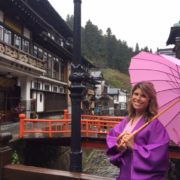Before coming to Japan I hadn’t heard of the Tohoku Region and now I’ve been completely charmed by this pastoral, natural part of northern Japan. This is the antithesis of the bright lights and hustle and bustle of Tokyo, and that’s what makes it special. Many retreat up North to enjoy farm fresh foods, breathtaking natural beauty and to take step back into Japan’s traditional roots.
1. Spend a morning at Hirosaki Castle
Though not quite a castle in the “fairytale” sense of the word, the Hirosaki Castle is a lovely Japanese style building, with ornate roof details and impressive silhouette. However, the real reason you visit is for the vast park that surrounds it. We happened to be fortunate enough to be visiting in the spring, when the cherry blossoms were at the height of their bloom. It felt like walking through a sea of pink, every different hue, with delicate petals floating in the breeze. The cherry blossoms created avenues of flowers, and I meandered over bridges that crossed the series of pleasant canals. Everywhere I turned was worthy of a photo–especially when I got to the viewpoint of the majestic snow capped mountain in the distance.
My Recommendation: Go there early (like 7am) if you want more flowers than people in your photos. Also, next time I go, I am bringing a picnic so I can waste an afternoon under one of the swaying sakura trees.
2. Eat Wanko-Soba

Tohoku is famous for its buckwheat noodle, soba. I tasted it in tea, in ice cream and in many variations of the noodle form. However, the best soba experience that I had was Wanko-Soba in Morioka. Here, diners are encouraged not only to eat soba but to eat as much as they can and as fast as they can. An average lunch can turn competitive as the waitresses serve you soba in small “mouthful” sized dishes. The waitresses tower over you, shouting encouragement as you slurp, refilling as fast as you can eat. Of course the other options were delicious as well–I really enjoyed their tuna sashimi and pickled vegetables. But if you plan to nab the record, don’t waste stomach space. You are going to need it since you’ll need to eat over one hundred bowls! Slurp!
My Recommendation: Bring a competitive friend and have a soba eating contest!
3. Stroll through a Samurai Village

Kakunodate
Tohoku is known for it’s storied Samurai culture and to get as close as you can to it today, visit Kakunodate, a well preserved Samurai town. There is one completely original house dating back 200 years and it’s still in the ownership of its original Samurai family line. There’s another home that also has a museum, just a few steps down. The museum has an impressive display of Samurai gear, with swords just like this Mini Katana and helmets. Even just wandering down the streets, stopping for an ice cream and to admire this organized village, makes for a picturesque visit.
My Recommendation: Earlier is better to avoid the crowds!
4. Commune with Nature

The rugged coastline of Tohoku blew me away. It looked like the Mediterranean coast or even New Zealand–but it certainly did not look like Japan. The Sanriku Fukko National Park stretches along a pristine part of the coast, with three steep trails that allow you to walk through old forests and view the majestic cliffs. There are three lookouts with views, number 2 being the best.
My Recommendation: If you want a good workout, hike all the way down to the beach to get up close with the bright blue waters.
5. Visit Teapot Workshop Iwachu Nambu Tekki

I hadn’t paid much attention to teapots until now. Tea is an extremely important part of Japanese culture and here at the factory, you can witness how some of the finest traditional teapots are made by hand. You can step inside the workshop, watching the craftsman painstaking create the signature dots that cover these iron pots. Each teapot takes about 2 weeks to create so it’s no wonder that they aren’t cheap. I toured the museum but was most taken by the gallery where their finest work is on display. Neon colors and even Hello Kitty tastefully grace some of the newer models of this old brand.
My Recommendation: Visit the workshop first to understand the intense labor and dedication needed to create each teapot. Then go to the shop and buy one for yourself!
BONUS TIP: GINZAN ONSEN

Ginzan-Onsen is a hot spring town, built lining a central spring. Stay at one of the handful of traditional style hotels, from boutique to more contemporary, each with their own onsen experience. The postcard worthy town has charming pedestrian bridges, boutique shops and several eateries. But the real reason to come here is to soak in the geo-thermal waters. I didn’t realize how therapeutic it could be until I tried it for myself. After a few minutes in the healing waters, I felt renewed from the inside out.
My Recommendation: Check out Ginzanso if you want large tatami style rooms with your own private onsen on your deck.
For more recommendations, leave me a comment! Be sure to tune in to CNN on May 18th to watch the full video of my Tohoku experience!






























 Connect with Kelley
Connect with Kelley


